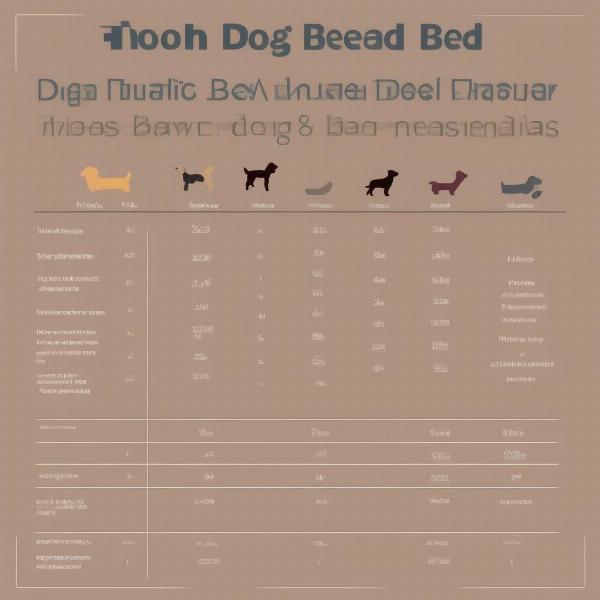A non-chewable dog bed can be a lifesaver for dog owners dealing with destructive chewing. But finding the right one can be a challenge. This guide will explore everything you need to know about non-chewable dog beds, from materials and construction to choosing the right size and style for your furry friend. We’ll also discuss tips for preventing destructive chewing and ensuring your dog’s comfort and safety.
What Makes a Dog Bed “Non-Chewable”?
No dog bed is entirely indestructible. However, “non-chewable” dog beds are designed with durable materials and reinforced construction to withstand significant chewing. These beds often incorporate features like tightly woven fabrics, reinforced seams, and chew-resistant corners. They’re designed to discourage chewing and last longer than standard dog beds.
Choosing the Right Non-Chewable Dog Bed
Selecting the perfect non-chewable dog bed involves several key considerations. First, consider your dog’s size and sleeping style. A larger dog will need a more spacious bed, while a dog that likes to curl up will appreciate a bolster bed. Next, think about the material. Some popular options include ripstop nylon, ballistic fabric, and heavy-duty canvas. Finally, consider your budget. Non-chewable beds often cost more than standard beds, but they can save you money in the long run by preventing frequent replacements.
Materials and Construction: Key Factors for Durability
The materials and construction of a non-chewable dog bed are crucial to its longevity. Look for beds made from tear-resistant fabrics like ripstop nylon or ballistic fabric. These materials are designed to withstand scratching, pulling, and chewing. Reinforced seams are another important feature, preventing your dog from easily ripping the bed apart. Additionally, consider beds with metal frames or chew-resistant corners for added protection.
 Comparison of Different Dog Bed Materials
Comparison of Different Dog Bed Materials
Preventing Destructive Chewing: Beyond the Bed
While a non-chewable bed can help, addressing the root cause of destructive chewing is crucial. Boredom, anxiety, and teething are common culprits. Providing plenty of mental and physical stimulation can help alleviate boredom. Interactive toys, puzzle feeders, and regular exercise can keep your dog engaged. For anxiety, consider creating a calming environment and consulting with a veterinarian or behaviorist. Teething puppies can benefit from chew toys specifically designed for their needs.
What if My Dog Still Chews the Bed?
Even with the most durable bed, some dogs may still manage to chew. If this happens, don’t despair. Try spraying the bed with a bitter apple spray, which deters chewing with its unpleasant taste. You can also redirect your dog’s chewing behavior by offering alternative chew toys.
Ensuring Comfort and Safety
While durability is key, your dog’s comfort and safety shouldn’t be overlooked. Choose a bed with adequate cushioning and support. Ensure the bed is appropriately sized for your dog, allowing them to stretch out comfortably. Also, consider the bed’s washability. Regular cleaning is essential for hygiene, and a removable, washable cover makes this process much easier.
Conclusion
Investing in a non-chewable dog bed can be a wise decision for owners of destructive chewers. By carefully considering factors like material, construction, size, and your dog’s individual needs, you can find the perfect bed to provide a comfortable and long-lasting resting place for your furry friend. Remember that addressing the underlying causes of chewing is also crucial for long-term success.
FAQ
-
Are non-chewable dog beds truly indestructible? No dog bed is entirely indestructible, but non-chewable beds are designed to withstand significant chewing.
-
What are the best materials for non-chewable dog beds? Ripstop nylon, ballistic fabric, and heavy-duty canvas are popular choices.
-
How can I prevent my dog from chewing their bed? Address the underlying cause of chewing, provide plenty of chew toys, and consider using a bitter apple spray.
-
How do I choose the right size non-chewable dog bed? Measure your dog and choose a bed that allows them to stretch out comfortably.
-
Are non-chewable dog beds easy to clean? Many non-chewable beds have removable, washable covers for easy cleaning.
-
What should I do if my dog still chews their non-chewable bed? Try redirecting their chewing behavior with alternative toys and using a bitter apple spray.
-
Are non-chewable dog beds worth the extra cost? They can be a worthwhile investment, saving you money on frequent replacements in the long run.
ILM Dog is a leading international pet website dedicated to providing expert advice and resources on all aspects of dog care. We offer a wealth of information on dog breeds, health, training, nutrition, grooming, and much more. From puppy care to senior dog care, we cover every stage of your dog’s life. Whether you’re a first-time dog owner or a seasoned expert, ILM Dog is your go-to resource for reliable and practical dog care advice. Need help choosing the right non-chewable dog bed? Our team of experts can help! Contact us at [email protected] or +44 20-3965-8624.